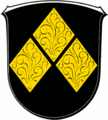Damascene (heraldry)
In heraldry , damascene is understood to be a field pattern as a means of representation for decorating and freshening up coats of arms with surface-filling patterns and ornaments in the style of arabesques or structured hatching .
The pattern, which is conceptually borrowed from Damascus steel , has increasingly appeared since the 15th century and has no further heraldic meaning. Damascus decorations are neither a coat of arms nor do they represent a change in the coat of arms, they are merely decorative. For this reason, the damascene must not be drawn so obtrusively or so strongly that it could be confused with a common figure or a heraldic variation of the field. This is especially true in the case of a single hatched field pattern, which could be confused with diamonds or a herald's image with a higher division . The damascene usually has the same tincture as the background, only in a lighter or darker shade, or one of the two metals gold or silver.
In the rarest cases the damascene is part of the blazon (description of the coat of arms) and is otherwise not subject to the heraldic color rule , like the secondary coat of arms parts .
The type of representation is adapted to the time epoch. In the Middle Ages there were simple regular figures, such as crossed lines ( crosses ), points, rosettes, and meanders . Damascus was very popular in the Renaissance , so it became lively and ornate structures that were symmetrically introduced into the coat of arms . Most of them were stylized imitations of plant tendrils , such as the lozenge or the vine . Their role model is the damascening in seals, where empty fields were filled in and thus could be distinguished from one another due to a lack of color rendering. Coats of arms are often damaged if there is no image of a herald , especially if other parts are very small, this removes the visual weight of large areas. Coats of arms that are covered with a common figure are usually not damascened.
The shelf field (or shelf sign) is usually shown with a damascus.
Damascus with a geometric figure ( crechers )
Colored field sampling ( Garmisch-Partenkirchen )
Damascus diamonds ( Eckelshausen )
"Two blue (Landsberger) posts on a damascene gold background " ( Zörbig )
Damascus fields ( Juva , Finland)
Extensive use ( Swabian Reichskreis )
Stained Glass (Diocese of Worcester , England)
literature
- Ottfried Neubecker : Damascus . In: Real Lexicon on German Art History . Volume 3: Book Desk - Dill. Druckermüller, Stuttgart 1953, column 1014 f.
Web links
- Introduction to Heraldry: Damascene - Bernhard Peter
Individual evidence
- ↑ Damascus. In: Leopold Rössler: Schmucklexikon.
- ↑ A Glossary of Terms used in Heraldry (English) - Glossary of terms in heraldry







